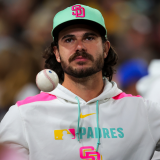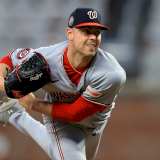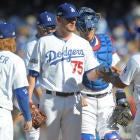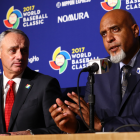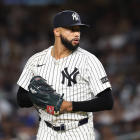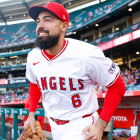Nationals-Dodgers NLDS Game 3 calls to mind baseball's slow pace concerns
The Nationals topped the Dodgers on Monday, but it certainly took a while

The Nationals edged the Dodgers in Game 3 of the NLDS on Monday (WAS 8, LAD 3), but it took a while. Specifically, it took four hours and 12 minutes. That's not a record for a nine-inning playoff game -- that "honor" belongs to the Yankees and Red Sox, who in Game 3 of the 2004 ALCS went at it for four hours and 20 minutes. In that game, though, the Yankees prevailed by a score of 19-8.
That is, the Yankees and Red Sox in their marathon scored roughly 245 percent more runs than the Nats and Dodgers did. Still and yet, the Nats and Dodgers took almost as long.
Stated another way, Indians-Red Sox ALDS Game 3 started three hours after Nationals-Dodgers, and it was already heading to the bottom of the sixth when the Nats wrapped things up in L.A. So what gives?
First, there this ...

The two teams combined to use 13 pitchers in Game 3, and five of those pitchers faced just two batters. Nothing tacks on the minutes of non-activity quite like pitching changes. As well, the Dodgers' pitchers this season were tied for third in all of MLB when it comes to the average time between pitches. They took 24.0 seconds between pitches on average against a league mean of 22.7 seconds.
Game 3 also saw the Dodgers use a number of their main offenders. Pedro Baez worked two infernal frames on Monday, and he led all pitchers in baseball this season with an average of 30.2 seconds between pitches. Close Kenley Jansen was third on the team with 27.7 seconds between pitches. Josh Fields wasn't far behind him. In all, every pitcher but one that the Dodgers used on Monday took longer than the league average between pitches. The lone one to beat the league average, Ross Stripling, threw just nine pitches on the day.
Besides the game dragging on in terms of raw hours and minutes, it was all too passive at times ...
According to PitchFX we just went 25½ minutes b/w balls in play (15:31.49-15:57.25).
— Doug Kern (@dakern74) October 10, 2016
K, pitching change, K, BB, PC, K, inning break. Snore.
Strikeouts eat up a greater percentage of the game than they ever have before, and there's no sign of that changing any time soon. Walks are also elevated relative to historical levels, and those are exactly founts of excitement. Joe Sheehan's written often and well about the current strikeout scourge and how it's sucking the life out of the game. He's right. I'll still take baseball in its current broken form over any other sport, but the game is at its most compelling when pitchers are pitching, hitters are hitting, and fielders are fielding. We're pretty light on the latter these days, and that was readily apparent for long stretches of time during Game at Dodger Stadium.
MLB commissioner Rob Manfred has of course made whittling down game times a priority, and to that end he's pushed through various tweaks prior to the 2015 and 2016 seasons. Game times are less of a concern for me than "game flow." In any event, there's still work to be done. As the Nationals and Dodgers acutely reminded us, baseball needs fewer pitching changes, less time between pitches, and more balls in play.


